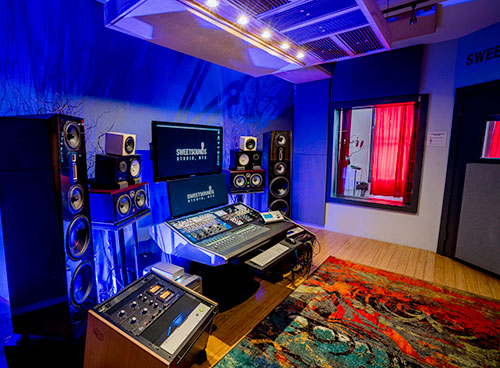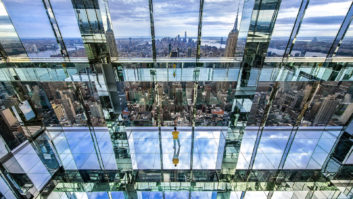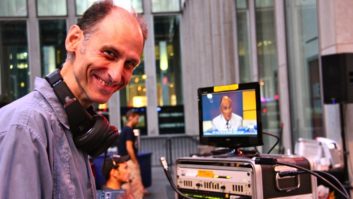
SWEETSOUNDS STUDIO GETS FACELIFT
After six years of serving clients, the team at SweetSounds decided it was time for a little recording studio nip and tuck. From the moment you walk in to all the way to the very back of the building, they’ve made improvements to all aspects of their space.
The facelift started recently when freelance studio designer Nick Emmet visited to help design new sound panels for the live room and the vocal booth. They built out 8-foot-tall by 3-foot-wide panels in the Broadway (B Room) vocal booth and did a similar build in the Crosby (A Room) live room, with more custom work throughout the live room space. They also added absorption-patterned panels onto the ceiling, and enlisted GIK Acoustics to build custom diffusors and polyfusors for placement throughout the room.
“We have seen a tremendous improvement in both spaces—the Broadway booth being perfect for vocals and solo instruments, while the diffusion and space in Crosby has now opened up the ‘lively’ sound of drums and smaller instrument tracking, yet keeping it warm and tight enough for vocal tracking sessions,” says Executive Producer and Founder Dinesh Boaz. “The clients have also appreciated the update and new aesthetic feel throughout the rooms.”

Crosby live room
From there, Boaz says they just kept adding things to their to-do list—new rugs, lights, wallpaper, diffusors, artwork, and so on. The goal was to keep the boutique feel but take it up a notch, giving it a designer and chic aesthetic, yet comfortable and homey vibe for artists to bring out their best work.
“I’ve been so excited to talk about all of the renovations we’ve been doing around here lately, and I think that’s because I’ve seen how much our hard work has started to pay off,” Boaz says. “I see new clients constantly being blown away by the setup, people are in love with the aesthetic, and we’ve been able to steadily grow our network through all of the positive energy.”
They recently swapped out their Neve 5088 console in the Crosby room with a more modern, faster-moving and easier to upgrade/maintain setup—both studio rooms are now equipped with Sterling Modular desks, Apogee Symphony audio interfaces and Legacy Audio mains, as well as tons of great pre’s, EQs and compressors, including those from API, Neve, Manley, Distressor and UAD. They also have an ADR setup in the Broadway room.

The Broadway room vocal booth
Some recent sessions—all in the Crosby room—include Saturday Night Live’s Jay Pharoah with engineer Brian Chirlo working on a track produced by Myles William for Future Moguls. They used a Neumann U 87 through a Heritage 1073 and a UA 1176, as well as RVerb, H-Delay and Crystallizer plug-ins…James Brown Orleans was tracking and mixing with engineer Josh Giunta. For vocal tracking they used a Neumann TLM 49 through Neve 511, API 550A EQ, Avalon Vt-737 EQ and Distressor; and Waves Ren EQ, Waves Q10, UAD Pultec EQ, Waves R-Resser, UAD LA-2A, Waves L2 plug-ins on vocals. For acoustic guitar tracking, they used a Neumann KM 184 and a Heritage 1073, and the following plug-ins: Waves Ren EQ, UAD Pultec EQ, UAD Neve 33609, EchoBoy and UAD 140 Reverb…Deepak Chopra worked on a meditation product voiceover with engineer Jay Wu Jun Yow. They used a TLM 49 through an Avalon Vt-737, a Neve 5088 channel and Pro Tools, as well as the plug-ins (Avid channel strips) RDesser and RVox…Arianna Huffington did a podcast Interview for The James Altucher Show with Jay Wu Jun Yow. On Altucher they used a TLM 49, Neve 511, and Distressor, and on Huffington they used a TLM 49 and an Avalon Vt-737—all into Pro Tools…Engineer David Wrench mixed a project for Tei Shi using Pro Tools and UAD plug-ins…Mixing and tracking engineer Eryck Bry worked on artist production and used a Neumann U 87, Heritage 1073, Distressor, and 1176 into Logic and Pro Tools.

The Steinway C at The Bunker
THE BUNKER ACQUIRES, REBUILDS STEINWAY C
The Bunker Studio recently replaced its Steinway M—which had been a fixture at the studio for about six years—with a Steinway C.
The piano is a full rebuild by Jim Ialeggio of Grand Piano Solutions in Massachusetts. Every element of the piano has been reworked, replaced and investigated to make sure it is functioning at the highest level. The piano is installed in Studio A and can be moved between the live, string and rhythm rooms with ease.
As the studio grew, staff began to realize the need to provide clients with a bigger piano. The Steinway C fit the bill: At 7 feet 6 inches, it provides the flexibility of placing it in multiple rooms in Studio A. It’s the second largest Steinway, and was designated as a “semi-concert grand” for small to medium-size concert halls. According to Aaron Nevezie, co-owner and chief engineer, the piano was manufactured in 1894, and Steinway only made the model C in New York until 1936. (John Davis is also co-owner and chief engineer at The Bunker.)
While The Bunker’s Steinway M had many fans, it was a little too small a piano for some players. “We wanted an instrument that would be undeniably great—inspiring from the moment a musician sat down to play—and large enough to work for featured piano performances like solo classical or jazz piano trio,” Nevezie says. “There seems to be a lack of truly excellent pianos in the New York studio scene, and it was important to us to offer this option to the community here.”
Nevezie says rebuilder Ialeggio is a master craftsman, and his process includes installing many special features. The fully tempered duplex scale protocol maximizes treble and high treble presence in a way that significantly improves the treble response. The bass section uses iron-wound strings rather than the usual copper wrap. These strings have a clearer fundamental with less “clanging” harmonic, leading to a focused, strikingly warm bass sound. The action is by WNG and made from composite/carbon fiber parts rather than the traditional wood pieces.
“Those are just a few of the unique technical qualities of this piano,” Nevezie says. “The actual sound of the instrument is incredibly even across the entire range. A client even described it as ‘freakishly even.’ The low end is powerful and clean, enabling the pianist to play voicings that would be muddy on other instruments, and the high end is strong and sparkling. We’re excited to get to know this instrument in the studio and hear it played by the many amazing pianists who pass through The Bunker.”
Over the next few weeks, professional piano tuner and technician James Carney will be tweaking the details as it settles into its new home.
In addition to the new piano, Nevezie says the The Bunker added a vintage LA-2A for each studio, a vintage LA-3A that will float between rooms, a Distressor for each room, GML 8200 Stereo EQ for each room and a Lexicon 480L for Studio B, as well as another vintage RCA-44BX ribbon mic and stereo Dolby SR for mixdown to the 2-track tape machine. They also added two ATR 102 2-track tape machines, one ½-inch and one ¼-inch. Heads are being relapped by John French and they will be overhauled by studio technician Ken McKim before being placed in service.







